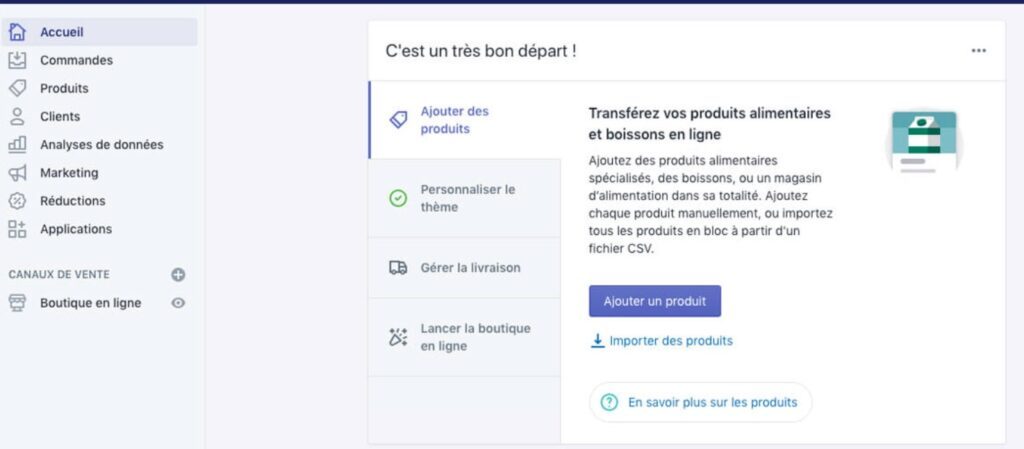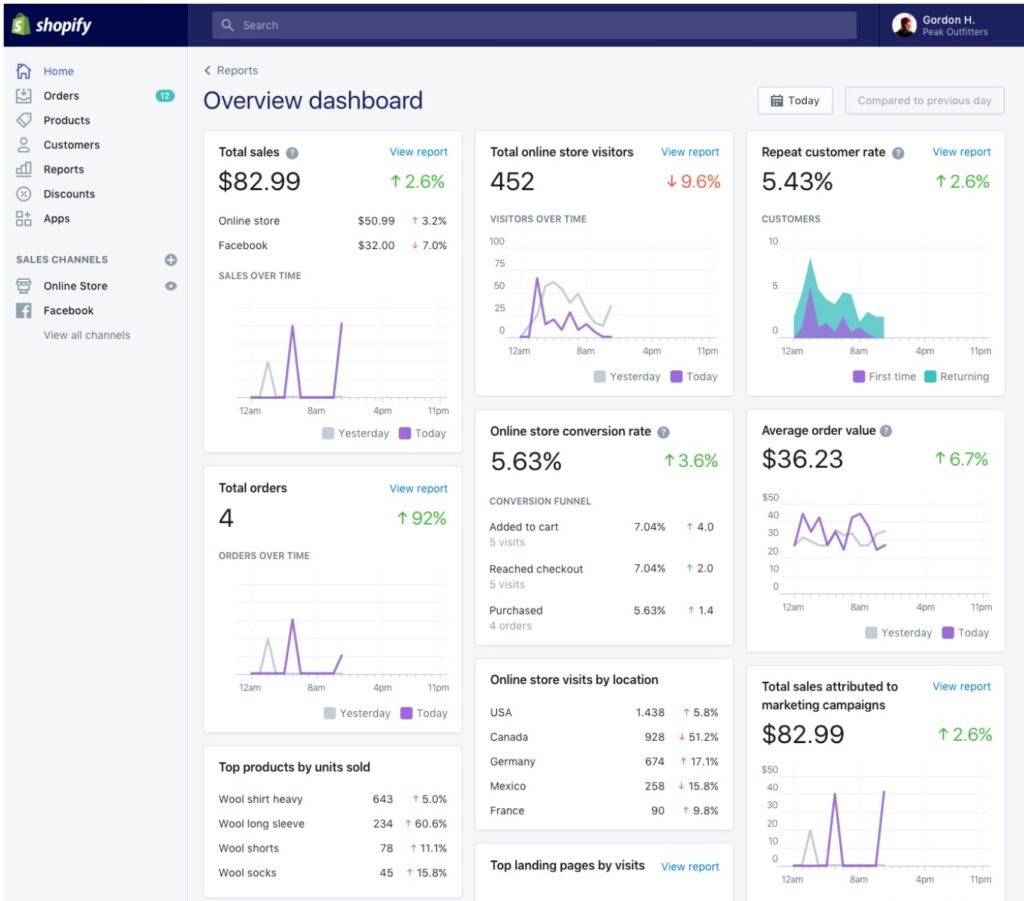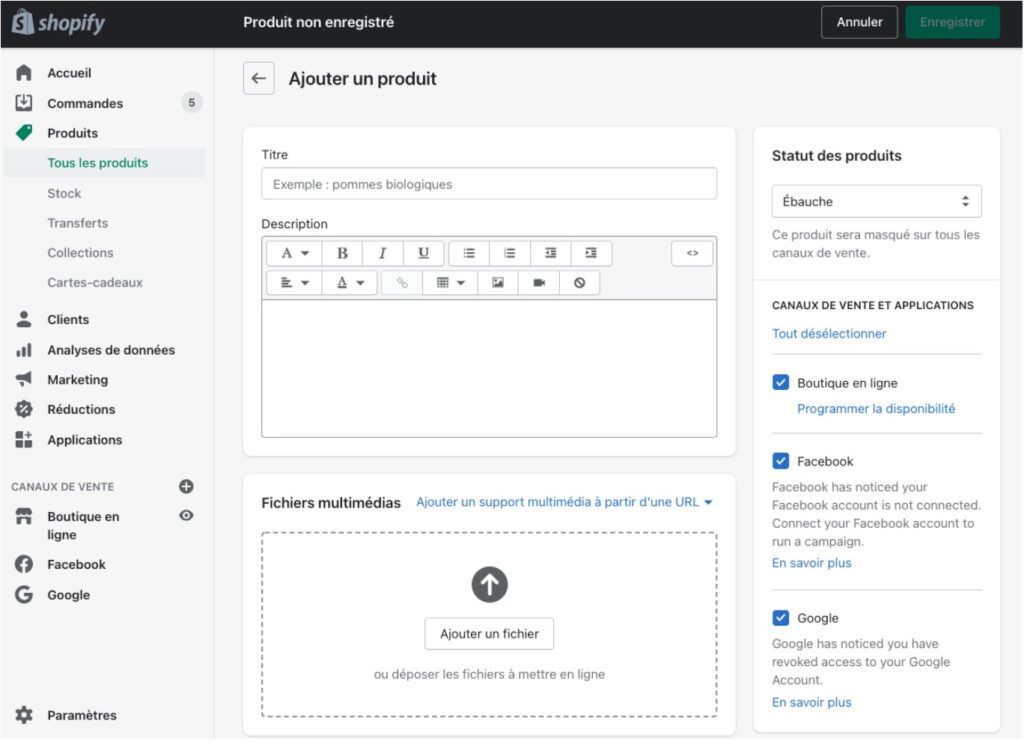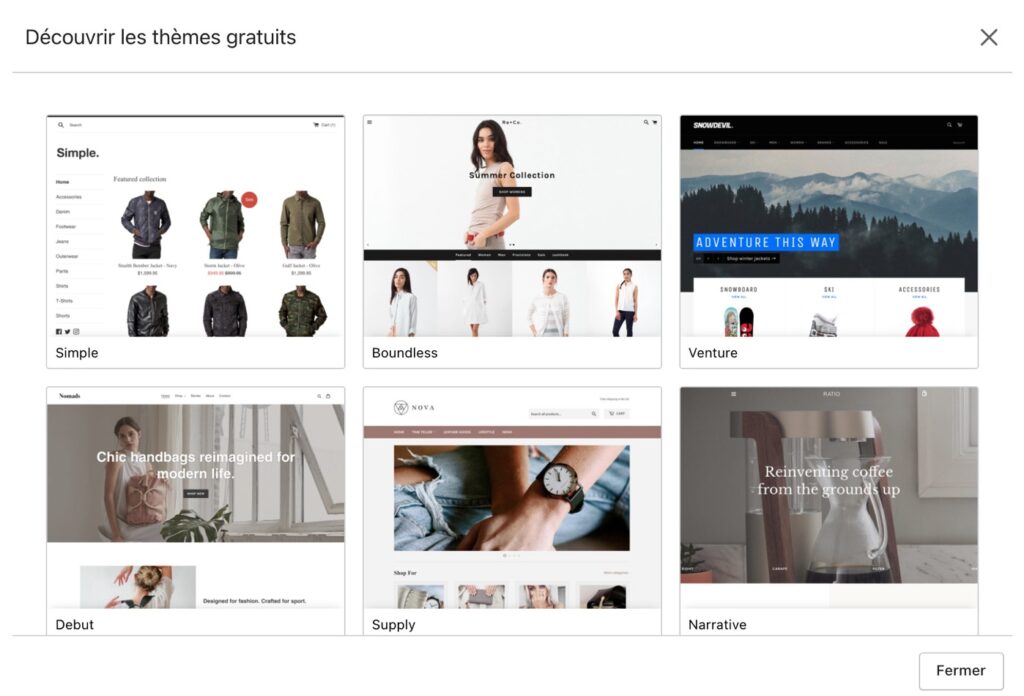
Result of our test: 4,8/5
Shopify is clearly the most complete e-commerce software on the market. No matter what your goals are, if you want to create a simple online store, this is the CMS to use!
If you want to create an online store, you have several options. You can code your e-commerce from scratch, but it requires great technical skills. Or you can use a CMS, which allows you to design an online store easily.
Among these software, we note Shopify, the most used CMS in the world to create an e-commerce. Shopify is an all-in-one tool that allows you to create a store without the need to code. Even without skills, you will be able to have a fast, mobile-optimized e-commerce design.
Today, we are going to present you in detail the test of Shopify so that you can get an idea of how it works.
Join 10,000+ makers and get all our latest tips for making a living from Blogging and Affiliate Marketing.
Contents
Shopify Overview
Shopify is a Content Managing System(CMS) . In short, it is a software that will allow you to create a website without coding. This is the software that offers the possibility to put your store online and add features, improve the graphic aspect and others.
Shopify is a Canadian company specialized in the design of e-commerce. Overall, if you want to create an online store, this software will take care of everything. He will host your website and your domain name, manage payments, shipping and more.
Another reason why Shopify is so popular is because it incorporates many templates that allow you to design a beautiful store quickly and easily. Thanks to themes designed by designers, even if you are bad in design, you will be able to create a professional store.
Worldwide, nearly 30% of eCommerce businesses run on Shopify. As a result, this CMS is used by both small online stores and large e-tailers. As such, there is no real limit with this CMS. Thanks to all the features, themes and extensions, there’s almost nothing you can’t do.
Who is Shopify for?
Shopify is an easy to use tool to create an online store. Therefore, as long as you want to design an e-commerce to sell your products or to do dropshipping, this CMS will suit you. There are several scenarios where Shopify can be used.
If you want to get into dropshipping(selling directly from an existing supplier like Aliexpress, wish, Amazon, etc.), Shopify is ideal. You will be able to connect the application Oberlo application to automate shipments from your suppliers.
Secondly, Shopify is ideal for small merchants. If you want to sell your own products online, this CMS will be perfect. Even without skills, you can create a professional online store. If you have a small structure, this CMS is ideal to build and manage your e-commerce on a daily basis without taking your head.
But if you have a bigger project, such as creating an e-commerce that generates hundreds of thousands of visits per month, it is also possible with Shopify. Indeed, the CMS is largely capable of running a large online store. With all the extensions available, there is really nothing you can’t do.
In summary, it should be understood that Shopify acts as an enabler to create an e-commerce. Therefore, as long as you want to create a store without having to worry about the technical part, this CMS is ideal.
Services offered by Shopify
As we told you above, Shopify offers a lot of features. We will introduce you to the most used services of the platform, so that you can get an idea of how it works.
Creation of a store
Shopify is above all simple to use and allows you to set up an online store step by step easily from the e-commerce platform . Overall, you will be able to add all your products for sale and sort them to create categories and pages. But you can also create a “single product” store with a single page.
You should know that even if you have never used this software, you will be guided by the platform. As soon as you get to Shopify, the CMS will show you how to add or import a product, integrate a theme, set up order shipping and more.

Shopify will guide you through all the steps of setting up your e-commerce. By following the steps shown directly from the platform, you will be able to put your store online quickly.
The most time consuming step is surely the addition of product. Indeed, for each product you add, you will have to fill in a lot of information such as its price, characteristics, and others. But you can also add photos, videos and a description.
On the home screen, you can see that Shopify asks you to choose a shipping method. Here you can choose between several options including shipping, local delivery or pick up.
Note that if you already have an online store on another CMS like WordPress, Wix or SquareSpace, you can migrate it to Shopify. Indeed, the platform allows to recreate an existing site created with another software.
Shopify also allows you to have a blog part on your site. We’ve talked about it before on our blog, if you own a business that sells online, it’s imperative to have a blog. By publishing articles, you will be able to attract free, warm and free, warm and regular traffic. This is a great way to attract customers in the long term so you don’t have to rely on advertising.

From the platform, you will be able to write complete blog posts, as it is possible to do with WordPress for example. You can add images, links, videos and more. It will also be possible tooptimize your articles for SEO(by adding extensions – see below).
Dashboard
The big advantage of Shopify is that you can manage your e-commerce and have a detailed report of your sales. This is the famous dashboard that you’ve already seen if you’re interested in online business. This dashboard will allow you to have access to all the necessary statistics to see the state of your sales.

This dashboard gives access to a lot of data. As not all of them are useful, we will present you the most interesting statistics to know.
Before you start, you should know that you can generate statistics for a day, a week, a month or a customized period of time.
The most interesting statistic, at least the one that all e-tailers look at, is the total sales. Here you can see an overview of your sales, but alsowhere the sales come from (advertising, organic visits, etc.).
Also very important is the number of visitors. At first glance, you can see how many people visit your store. But you can also get a more detailed report, to see the average time spent on your store, the most visited pages, the bounce rate and others.
On the right, you can see the customer retention rate. This percentage represents the amount of customers who recommend your website after purchasing a product. At the same time, you can observe the percentage of customers who buy for the first time on your store.
Underneath, Shopify displays the number of open orders. Note that a separate section on the platform allows you to see the orders to be processed. Right next to that, a very important statistic is your conversion rate. You will also be able to see the percentage of visitors who add a product to the cart.
👉 You are encouraged to check your conversion rate regularly, as it is a key indicator of your marketing performance.
Then you can also see the average basket. Again, this is an important indicator to define your marketing strategy. The objective is of course to increase this average basket. There are several techniques to implement in order to sell more.
Finally, one last really interesting statistic is going to be the revenue per marketing campaign. Thanks to a detailed report, you will be able to see the conversion rate, the average basket of customers from an advertising campaign.
Themes
To personalize your store, you can add a theme. Themes will allow you toimprove the graphic aspect of your site very easily. Generally, themes are built by designers and developers.
The goal of a theme is to make your store more design. But the themes must also be optimized so as not to slow down the loading time of the pages. Some themes are therefore very design, but too heavy and therefore decrease the speed of your site.
There are free and paid themes. If many free themes provide a lot of options, we prefer to be honest, it is better to start with a premium theme. Especially if you want to create a design store without reducing the performance of your site.

As you can see, some themes will add features, which are not available if you keep the basic Shopify theme. You can for example add carousels, stock counters and timers, and others.
Some themes also offer pre-made e-commerce templates. In this case you can import a template with several pages, but also product and category sheets . Then, you just have to modify the template with your products, your text and others. It is an ultra simple and fast way to create your e-commerce.
In our opinion, the addition of a theme is essential to create an online store worthy of the name. We therefore invite you to get information before starting your e-commerce to choose the theme that suits you. Quickly, here are the criteria of a good Shopify theme 👇
A theme must be fast. Design is important, but if it slows down the loading time of your pages, you will lose visitors. We therefore invite you to check that your theme is not too heavy before installing it on your store.
Also, it is better to choose a theme that is optimized for SEO. SEO is very important to develop your e-commerce. With an optimized theme, you can more easily have an effective SEO strategy.
As a bonus, some themes allow you todisplay your site in several languages. If you want to sell internationally or simply in neighboring countries, it can be interesting.
Extensions
Shopify includes many extensions that will allow you toadd features to your store. There are thousands of extensions, some of which are free and some of which are paid. Many of them are also based on a freemium model, i.e. with a free but limited version.
We will quickly introduce you to some extensions that are essential on Shopify.
The Boost Sales plugin allows you to add UpSells “and CrossSells “. Globally, as soon as a customer places an order, you will be able to display a page in order to offer him another product. This allows you to increase your average basket easily.
If you want to do dropshipping, the Oberlo application will be essential. This application allows you to order and ship your orders directly from your supplier(mainly Aliexpress). The extension also allows you to manage stock and track shipments in real time.
Next, we recommend that youinstall several extensions tooptimize your site for SEO. The basic features of Shopify allow you to change some things, but we don’t think that’s enough. We invite you to install Plug In SEO which will allow you to optimize several elements and to correct your mistakes. You can also download SEO Image Optimizer to optimize your images for SEO.
We also recommend that you install Mailbot, an email marketing . With this plugin, you will be able to collect emails directly from your store. But the extension also allows you tosend email campaigns, such as promotional emails, newsletters and more.
You can also add the Yotpo Reviews plugin. This extension will allow you toadd customer reviews to your product pages. It is also this plugin that will let customers leave a review when they place an order.
Finally, we recommend the Referral Candy plugin. It will allow you to create an affiliate program for your online store. Publishers will be able to join your program and promote your products in exchange for a commission. You can also create promo codes for your affiliates from this application. Note that the extension takes care of everything, from affiliate registration to commission payments and sales tracking.
Customer support
Shopify is easy to use, but there may be issues with managing your store. In order to answer your problems, a customer support is available. There are several specificities to the customer support of your platform, which we will present to you.

You should know that there are several ways to contact customer service. In order to get a quick answer, you can start a web chat with a Shopify employee. The only drawback is that you will have to speak English, as the company’s operators only speak this language. The chat is available 24 hours a day and allows you to get a quick answer. If you are in a hurry, this is ideal.
As you can see, it is possible to contact Shopify on Twitter . It is also a quick way to get an answer. But in our opinion, it is better to go through the platform in order to have an answer to your questions.
If you want to have a contact with the French support, you will have to do it by mail. Generally, the response time is longer.
Finally, Shopify also has a discussion forum. On this forum, you can find Shopify employees, but also many users of the CMS, some of whom have become experts after years of use. You can register for free and ask your questions. Many users will be happy to answer your questions, but can also give an objective opinion on your store for example.

But you can also find the answer to your question simply by searching through the discussions that have already taken place.
The rates

Shopify offers 3 different pricing plans. Depending on the package you choose, many features can be added. Depending on the subscription plan, you can also have more or less administrator accounts to work with your collaborators on your store. Shopify and Advanced plans also provideaccess to more detailed analytics reports.
Secondly, you should know that Shopify takes a commission from you for every sale on your store. This percentage varies from 1.8 to 1.4% depending on the formula. Obviously, the more expensive your subscription, the lower the commission. (in case you make a lot of sales, the most expensive plan becomes the most advantageous)
Note that no matter which subscription plan you choose, the first 3 months will cost only 1€ per month.
Advantages & Disadvantages
After testing Shopify for several weeks, here are the strengths and weaknesses that stand out:
The advantages
✅ Easy to use
✅ Many templates to create a design site
✅ Good value for money
✅ Ability to accept payments in multiple currencies
✅ Marketing reports and statistics
The disadvantages
❌ English-only customer support
❌ Commission on each sale
In summary: our opinion on Shopify
Our opinion of Shopify is simple. It is clearly the ultimate CMS if you want to create an online store. The software is easy to use and will allow you to have a professional, design and optimized e-commerce. Thanks to all the available extensions, you can do absolutely everything in your store.
In addition to the ease of use that allows you to have an e-commerce design easily, this CMS is optimized for SEO. Thanks to some plugins, you will be able to manage your SEO strategy in order to gain places on the search engines.
As for the choice of the formula, it’s up to you. If you are just starting out and want to create an online store to sell your own products, the entry-level solution is perfect. But once you start making a lot of sales, the Advanced formula will no longer be profitable.
In our opinion Shopify offers good value for money. There are certainly cheaper CMS that allow you to create an online store, but they are not as easy to use. With Shopify, you can literally create a beautiful e-commerce without any special skills .
In conclusion, we recommend Shopify, which is by far the most advantageous and easiest solution to design an e-commerce. Thanks to the templates and applications, creating an online store is clearly child’s play. But the daily management of your e-commerce will also be simplified.
Join 10,000+ makers and get all our latest tips for making a living from Blogging and Affiliate Marketing.
The alternative to Shopify
Shopify is in our opinion the most complete software to design an online store. However, there are alternatives that like this platform allow you to create an e-commerce without the need to code. So we’re going to show you the best alternatives if you don’t want to use Shopify.
To begin with, we think of WooCommerce. This completely free extension of the WordPress CMS allows you to create a professional online store. The software is a bit more complicated to use than Shopify, but still allows you to save a lot of money. If you’re not afraid of training or are comfortable with the technical part, WooCommerce is ideal to start with very little budget.
Then you can use Wix . This platform allows you to easily create an e-commerce thanks to many templates. The software is very easy to use and offers the possibility to create an online store quickly. The subscription is similar to Shopify for the same features. This in itself is the alternative that is most similar to Shopify.
Finally, we also think of SquareSpace a simple to use CMS designed to create websites. With this platform, you will be able to design an e-commerce very quickly thanks to the numerous templates available. The rates are similar with subscriptions ranging from 11 to 36€ per month.
How to use Shopify?
There are hundreds of different ways to use Shopify, which will correspond depending on the type of store you want to have. We will show you how to get started with this CMS in order to set up your first online store.
👉 Before you start, you should know that you can start a free trial to use Shopify without paying(or 1€ per month) for 3 months. We invite you to do so before starting this tutorial.
When you arrive, you will have to choose your domain name. It will be the name of your store, but also its virtual address. In other words, your visitors will type this name in their search bar to access your e-commerce. We invite you to take your time before choosing this name.
Shopify will also ask you to include a logo, slogan and more. Don’t worry, you can change everything later. It is best to prepare several elements before starting your store, including a project idea and products to sell.
Then you can start adding your products. Each time, you will have several elements to integrate. You will need to add a title, a selling price, a description, photos/videos, and more. In fact, you can customize each product page via a number of elements. So it’s up to you to see what elements you want to change on each product.

Next, you are invited to create the most important pages for your store. This is going to be a contact page, an about page, a FAQ page, privacy policy pages, refunds, returns and more.
Once you have a few products online and your main pages are in place, you can add a theme to your store. As you have seen, a theme allows you toeasily improve the graphic aspect of your site. There are thousands of themes, both free and paid, that can add a design touch to your store.

Be careful,adding a theme can greatly change the visual aspect of your store. We invite you to install it as soon as possible on your site. Otherwise, you will have to modify many elements and this may waste your time.
By opting for a premium theme, you will have access to templates in order to easily create a homepage design. If you are just starting out, we invite you to choose a template and modify it with your products, your store name, your slogan, etc. (many tutorials are usually presented by the theme manufacturers)
Next, you will customize your navigation menus. This will allow your visitors to easily find your products or a way to contact your customer service for example. Here you can also choose different colors, typography and other.
Right after that, it’s time to customize the payment process. Here, you should know that Shopify allows you to have a lot of options to manage this process. For example, you may or may not require customers to create an account before ordering. But you can also ask customers what contact methods they prefer, collect emails and automate the sending of emails for abandoned carts for example.
Once this is done, you can connect your payment processor(Stripe, PayPal, etc.). As soon as everything is ready, you can put your store online.



